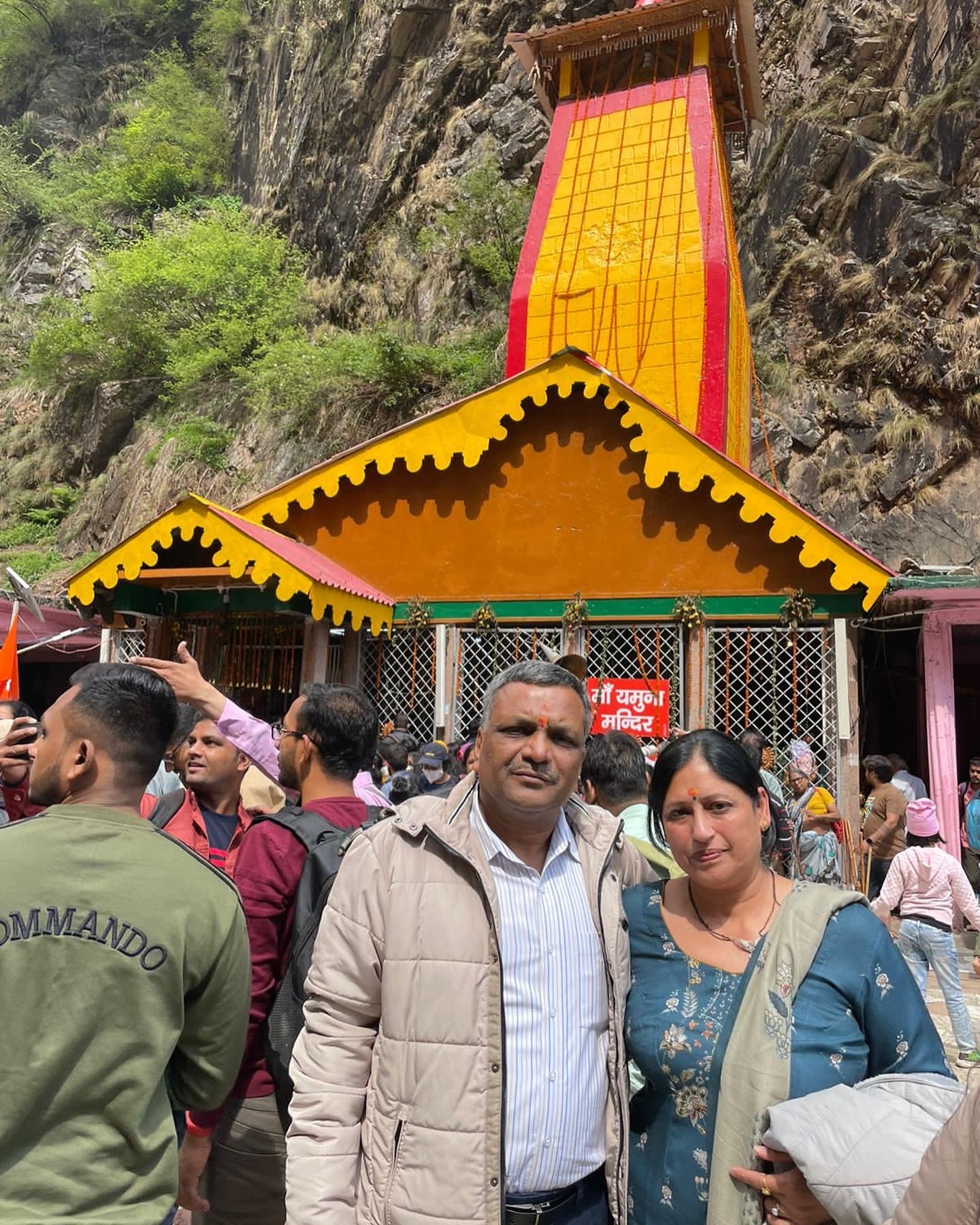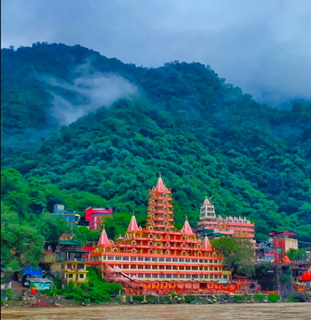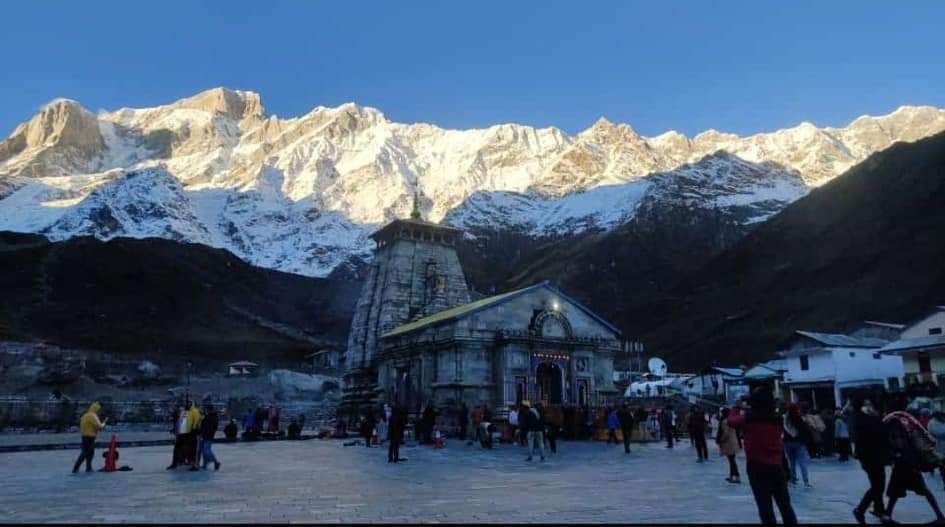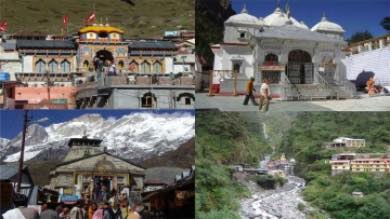Chardham Yatra
The Chardham Yatra in Uttarakhand is not just a physical journey; it's a spiritual odyssey that holds immense significance for millions of devout Hindus. Embarking on this pilgrimage is believed to offer profound spiritual benefits and personal transformation. Here's why one should consider undertaking the Chardham Yatra:
Spiritual Cleansing and Purification: The Chardham Yatra is considered a means to cleanse oneself of sins and impurities. The rigorous journey and the rituals performed at each holy site are believed to purify the soul and offer spiritual redemption.
Connection with Divinity: Visiting the sacred shrines of Yamunotri, Gangotri, Kedarnath, and Badrinath provides a unique opportunity to connect with the divine forces associated with each location. It's believed that the blessings of the deities at these shrines can help seekers on their spiritual path.
Test of Faith and Endurance: The challenging terrain and unpredictable weather conditions test not only physical endurance but also one's faith and determination. Overcoming these challenges instills a sense of accomplishment and strengthens one's belief in their spiritual journey.
Personal Transformation: The Chardham Yatra is often described as a transformative experience. The introspection and reflection that occur during the journey can lead to personal growth, self-discovery, and a deeper understanding of oneself and one's beliefs.
Cultural and Historical Immersion: The yatra offers a chance to immerse oneself in the rich cultural and historical heritage of the region. The temples and sites along the way are often adorned with intricate architecture and carry stories of ancient traditions.
Escape from Materialism: In the modern world, where materialism often takes center stage, the Chardham Yatra provides an opportunity to detach from worldly possessions and focus on the spiritual aspect of life. It's a chance to step away from the hustle and bustle of daily life and reconnect with the essentials.
Unity and Camaraderie: The yatra is often undertaken by groups of pilgrims, fostering a sense of unity and camaraderie. Sharing the journey with fellow seekers can create lasting bonds and a feeling of belonging to a larger spiritual community.
Nature's Majesty: The stunning landscapes and panoramic views of the Himalayas encountered during the journey are awe-inspiring. The beauty of the natural world serves as a reminder of the grandeur of creation and can deepen one's sense of awe and humility.
Time for Contemplation: The long treks and periods of solitude provide ample time for contemplation and introspection. This can lead to a deeper understanding of one's spiritual journey and life's purpose.
Devotion and Surrender: Undertaking the Chardham Yatra requires a level of devotion and surrender. The willingness to endure challenges and hardships in the name of faith reflects a profound dedication to spiritual growth.
In conclusion, the Chardham Yatra goes beyond being a religious expedition; it's a transformative journey that offers spiritual enrichment, personal growth, and a deeper connection with the divine. By taking on the challenges of the yatra, individuals can experience profound change, a renewed perspective on life, and a sense of spiritual fulfillment that lingers long after the journey ends.
Chardham Yatra Route
The Chardham Yatra route is a pilgrimage circuit that encompasses four sacred Hindu shrines located in the picturesque state of Uttarakhand, India. These four shrines—Yamunotri, Gangotri, Kedarnath, and Badrinath—are considered among the holiest destinations for Hindus, and the journey to these shrines is an integral part of the spiritual tradition. Let's delve into the elaborate route of the Chardham Yatra:
Yamunotri:
The Chardham Yatra typically begins at Yamunotri, the origin of the Yamuna River. Pilgrims travel from their point of arrival (usually Haridwar or Rishikesh) to the town of Hanuman Chatti, which is the base camp for the trek to Yamunotri. The trek covers a distance of approximately 6 kilometers and passes through lush forests, bubbling streams, and picturesque landscapes. The highlight of the trek is the Yamunotri temple, which stands at an elevation of 3,293 meters.
Gangotri:
From Yamunotri, pilgrims proceed to Gangotri, the source of the Ganges River. The journey involves traveling to the town of Harsil and then proceeding to Gangotri, which is accessible by road. The Gangotri temple, dedicated to Goddess Ganga, is the focal point of this stop. The temple is located at an elevation of 3,100 meters and offers stunning views of the surrounding mountains.
The route from Gangotri to Kedarnath is a bit longer and requires more effort. Pilgrims travel from Gangotri to Guptkashi, a town that serves as a base for the Kedarnath trek. From there, they undertake a challenging 14-kilometer trek to reach Kedarnath, which is situated at an altitude of 3,583 meters. The Kedarnath Temple, dedicated to Lord Shiva, is a key pilgrimage site. Alternatively, some travelers choose to reach Kedarnath by helicopter.
The final leg of the journey takes pilgrims from Kedarnath to Badrinath, the abode of Lord Vishnu. From Kedarnath, travelers make their way to Joshimath, which is the starting point for the journey to Badrinath. A short drive or a trek of around 6 kilometers takes pilgrims to the Badrinath Temple, situated at an altitude of 3,133 meters. This temple is one of the holiest shrines in Hinduism and marks the end of the Chardham Yatra circuit.
The Chardham Yatra route covers a diverse range of landscapes, from the serene Yamuna and Ganges rivers to the rugged Himalayan terrain. The journey involves trekking, driving, and sometimes even helicopter rides, allowing pilgrims to experience the natural beauty and spiritual significance of each location. Along the route, there are numerous smaller shrines, breathtaking viewpoints, and opportunities for reflection and meditation.
The Chardham Yatra is not only a physical journey but also a profound spiritual experience that takes travelers through some of the most awe-inspiring landscapes in the world. It's a journey that connects devotees with their faith, themselves, and the majestic natural world around them.
Travel tips for chardham yatra
Here are some important travel tips to consider for a smooth and enjoyable Chardham Yatra:
- Plan Ahead: Research the route, weather conditions, and local customs before embarking on the journey. Make accommodation and transportation arrangements in advance.
- Health and Fitness: The yatra involves trekking and traveling through high altitudes. Ensure you're physically fit and consult a doctor before undertaking the journey, especially if you have any health concerns.
- Pack Wisely: Pack comfortable and appropriate clothing for varying weather conditions. Include warm clothes, rain gear, trekking shoes, and essentials like first aid kit, medicines, and personal hygiene items.
- Stay Hydrated: Carry a sufficient supply of bottled water to stay hydrated during the journey. Be cautious with the consumption of water from natural sources.
- Altitude Sickness: Acclimatize properly to the high altitudes to avoid altitude sickness. Take breaks during treks and stay hydrated. If you experience severe symptoms, descend to lower altitudes.
- Travel Light: Keep your luggage manageable. It's recommended to carry a small backpack with essentials during treks and leave your main luggage at your accommodation.
- Local Cuisine: Enjoy the local food, but be cautious about what you eat to avoid any digestive issues. Carry some non-perishable snacks as well.
- Cash and ATMs: Carry sufficient cash as ATMs may not be readily available in remote areas. Also, inform your bank about your travel plans to avoid any issues with your debit/credit cards.
- Communication: Mobile network coverage can be inconsistent in remote areas. Inform your family about your travel plans and keep a list of emergency contact numbers.
- Respect Local Customs: The Chardham Yatra is a spiritual journey, so be respectful of the local customs and traditions. Dress modestly, remove shoes before entering temples, and maintain decorum during rituals.
- Photography: Respect photography guidelines at religious sites. Ask for permission before taking photos, especially of people.
- Environmental Conservation: Help keep the surroundings clean by avoiding littering and using trash bins. Respect the natural beauty of the region.
- Permit and ID: Carry a valid identification card and any necessary permits, especially if you're traveling to border areas.
- Local Guidance: Consider hiring a local guide who is familiar with the area and can provide insights into the culture, history, and geography.
- Safety First: Prioritize safety at all times. Follow the instructions of local authorities and your tour guides.
- Remember that the Chardham Yatra is not only a physical journey but also a spiritual and cultural experience. Approach the journey with an open heart, a positive attitude, and a sense of reverence for the places you'll be visiting.
Places associated with Chardham Yatra
Panch Prayag
Panch Prayag refers to the five confluences of rivers that hold significant religious importance in Hinduism, particularly in the Uttarakhand region of India. These confluences are considered holy and are an integral part of pilgrimage routes, including the Chardham Yatra. Here are the five Panch Prayag locations:
- Vishnuprayag:
Located at the confluence of the Alaknanda River and the Dhauliganga River, Vishnuprayag is the first of the Panch Prayag sites. It's named after Lord Vishnu and is situated at the town of Joshimath.
- Nandaprayag:
Nandaprayag is where the Alaknanda River meets the Nandakini River. This confluence is associated with the worship of Lord Nanda, an incarnation of Lord Vishnu. The town of Nandaprayag is named after this holy site.
- Karnaprayag:
Karnaprayag is the confluence of the Alaknanda River and the Pindar River. It's named after Karna, a heroic figure from the Hindu epic Mahabharata. This site is known for its cultural significance and stunning natural surroundings.
- Rudraprayag:
At Rudraprayag, the Alaknanda River meets the Mandakini River. The town of Rudraprayag is named after Lord Shiva (Rudra), and it's one of the more prominent Panch Prayag sites.
- Devprayag:
Devprayag is the confluence of the Alaknanda River and the Bhagirathi River, which is considered the source stream of the Ganges River. This is one of the most significant confluences and is revered as the starting point of the Ganges River.
Each Panch Prayag has its own historical and mythological significance.
Pilgrims often visit these sites to take part in rituals, offer prayers, and seek blessings. The confluences are also picturesque locations surrounded by the Himalayan mountains, making them spiritually enriching as well as visually stunning.
Panch Kedar
Panch Kedar refers to a group of five sacred Hindu temples dedicated to Lord Shiva, located in the Garhwal region of Uttarakhand, India. These temples are significant pilgrimage sites for devotees of Lord Shiva and are associated with various legends from Hindu mythology. The Panch Kedar temples are as follows:
- Kedarnath:
Kedarnath is the most famous of the Panch Kedar temples. It's situated near the source of the Mandakini River and is dedicated to Lord Kedarnath, a form of Lord Shiva. The temple is located at an elevation of around 3,583 meters and can be reached via a trek or helicopter ride.
- Madhyamaheshwar:
Madhyamaheshwar is located at an altitude of about 3,490 meters and is dedicated to Lord Shiva in the form of the navel (madhya) of a bull, symbolizing divine energy. The temple is accessible through a trek from Uniana, followed by a steep ascent.
- Tungnath:
Tungnath is one of the highest Shiva temples in the world, situated at an altitude of about 3,680 meters. It's considered the arms (bahu) of Lord Shiva. The trek to Tungnath starts from Chopta and offers breathtaking views of the surrounding peaks.
- Rudranath:
Rudranath temple is located amidst lush meadows at an altitude of about 3,600 meters. It's dedicated to Lord Shiva's face (mukh), and the trek to the temple takes pilgrims through picturesque landscapes.
- Kalpeshwar:
Kalpeshwar is dedicated to Lord Shiva's hair (jata), and it's the smallest and least visited of the Panch Kedar temples. The temple is located at an altitude of around 2,134 meters, and a short trek leads to this tranquil site.
The Panch Kedar temples are usually visited in a specific order as part of a spiritual journey, similar to the Chardham Yatra. The trekking routes to these temples provide pilgrims with an opportunity to experience the natural beauty of the region, witness stunning vistas of the Himalayas, and immerse themselves in the spiritual atmosphere. Each temple has its own unique charm and significance, contributing to the spiritual legacy of the Panch Kedar pilgrimage.
Panch Badri
The Panch Badri refers to a group of five sacred Hindu temples dedicated to Lord Vishnu, specifically in his Badri form, located in the state of Uttarakhand, India. These temples are part of a significant pilgrimage circuit and hold great religious importance for devotees of Lord Vishnu. Here are the five temples that make up the Panch Badri:
- Badrinath:
Badrinath is the most renowned of the Panch Badri temples and is situated in the town of Badrinath. It's dedicated to Lord Badri Vishal, a form of Lord Vishnu. The temple is nestled in the Garhwal Himalayas and is accessible via a well-known pilgrimage route. Badrinath is also a part of the Chardham Yatra.
- Yogadhyan Badri:
Located in the village of Pandukeshwar, Yogadhyan Badri is dedicated to Lord Vishnu in a meditative posture. It is believed that King Pandu of the Mahabharata performed penance at this site. The temple can be reached through a trek from Govind Ghat.
- Bhavishya Badri:
Bhavishya Badri is located in the village of Subhain, and it's believed that this temple will gain prominence in the future. The temple is dedicated to Lord Vishnu in a future-predicting form. The trek to Bhavishya Badri takes pilgrims through picturesque landscapes.
- Vridha Badri:
Vridha Badri is situated in the Animath village and is dedicated to an elderly or "vridha" form of Lord Vishnu. The idol is believed to be several thousand years old. The temple is visited after the Badrinath pilgrimage.
- Adi Badri:
Adi Badri is a complex of 16 temples located in the Adi Badri area. It's considered the first Badri among the Panch Badri temples. The temples are scattered in a picturesque setting and hold historical significance.
The Panch Badri pilgrimage provides devotees with the opportunity to not only seek the blessings of Lord Vishnu but also to explore the natural beauty and cultural heritage of the region. Similar to other pilgrimage circuits, the Panch Badri Yatra involves visiting these temples in a specific sequence, often beginning with Badrinath. Each temple has its own distinct architecture, legends, and spiritual significance, contributing to the overall spiritual tapestry of the Panch Badri pilgrimage.
Swargarohini Mountain
Swargarohini is a mountain located in the Garhwal region of the Indian state of Uttarakhand. It holds significant mythological and spiritual importance in Hinduism and is often associated with the epic Mahabharata. The name "Swargarohini" roughly translates to "the path to heaven."
Key points about Swargarohini mountain include:
Mythological Significance: According to Hindu mythology, Swargarohini is believed to be the mountain where Yudhishthira, the eldest Pandava, began his final journey to heaven along with a dog, ultimately reaching the gates of paradise.
Pilgrimage and Trekking: Swargarohini is a popular trekking destination for adventure enthusiasts and trekkers. The trek to Swargarohini offers breathtaking views of the surrounding Himalayan peaks, glaciers, and picturesque landscapes.
Trek Route: The trek to Swargarohini typically starts from the town of Gangotri, which is a well-known pilgrimage site itself. The trek involves passing through various scenic locations, including the picturesque villages of Chirbasa, Bhojwasa, and Tapovan.
Chirbasa and Bhojwasa: These are campsites along the trekking route to Swargarohini. Chirbasa is known for its dense forests and the Bhagirathi River, while Bhojwasa is situated near the Gaumukh Glacier, the source of the Ganges River.
Tapovan: Tapovan is a high-altitude meadow known for its spiritual significance and stunning panoramic views of the surrounding peaks, including Shivling, Meru, and
Bhagirathi Parbat.
Difficult Terrain: The trek to Swargarohini can be challenging due to its steep and rugged terrain. Trekkers need to be physically fit and prepared for changing weather conditions.
Glacial Lakes: The trek takes you past glacial lakes such as Kedar Tal, which adds to the natural beauty of the region.
Cultural and Religious Significance: While Swargarohini is primarily known for its natural beauty and trekking opportunities, it is also part of the larger spiritual and cultural landscape of the region due to its connection with the Mahabharata.
Swargarohini's association with the epic story of Yudhishthira's journey to heaven, combined with its stunning vistas and challenging trekking routes, make it a destination of interest for both religious pilgrims and adventure seekers.
Nearest Airport and Railway Station:
- Yamunotri: The nearest airport to Yamunotri is the Jolly Grant Airport in Dehradun, which is approximately 210 kilometers away. The nearest railway station is also Dehradun Railway Station.
- Gangotri: The Jolly Grant Airport in Dehradun is the nearest airport to Gangotri as well. The nearest railway station is Rishikesh Railway Station.
- Kedarnath: The nearest airport is the Jolly Grant Airport in Dehradun, and the nearest railway station is Rishikesh Railway Station. From there, the pilgrimage involves a combination of road and trekking.
- Badrinath: The nearest airport is the Jolly Grant Airport in Dehradun, and the nearest railway station is Rishikesh Railway Station.
Frequently asked questions (FAQ) guide on how to go on the 4 Dham Yatra by helicopter:
Q1: What is the 4 Dham Yatra by helicopter?
- The 4 Dham Yatra by helicopter is a pilgrimage tour that covers the four sacred Hindu shrines of Yamunotri, Gangotri, Kedarnath, and Badrinath in the Himalayan region of India via helicopter for a more convenient and faster journey.
Q2: How can I book a 4 Dham Yatra by helicopter?
- You can book this yatra through various tour operators and travel agencies specializing in religious tours. Online booking options may also be available.
Q3: Which are the four Dhams covered in this yatra?
- The four Dhams included in this yatra are Yamunotri, Gangotri, Kedarnath, and Badrinath.
Q4: What is the duration of the 4 Dham Yatra by helicopter?
- The duration of the yatra can vary, but typically it spans several days, allowing you to visit each of the four Dhams one by one.
Q5: When is the best time to undertake the 4 Dham Yatra by helicopter?
- The best time for this yatra is usually during the summer months (May to June) and early autumn (September to October) when the weather is favorable for helicopter travel, and the shrines are open for devotees.
Q6: Is the helicopter journey safe for the 4 Dham Yatra?
- Helicopter services for the 4 Dham Yatra are generally operated by reputable companies and follow safety protocols. It's considered a safe mode of travel, but it's essential to follow all instructions provided.
Q7: What should I wear and carry for the yatra?
- Wear comfortable and modest clothing suitable for the pilgrimage. Carry necessary documents, ID proofs, warm clothing (if traveling in early autumn), and essentials like water, snacks, and any prescribed medications.
Q8: Are there any age restrictions for this yatra?
- Generally, there are no strict age restrictions, but it's advisable to consult with the tour operator for specific guidelines, especially for elderly or young participants.
Q9: Can I get accommodation near the shrines during the yatra?
- Accommodation options vary, and some tour packages may include stay arrangements. It's advisable to check with your tour operator for details on accommodation.
Q10: Is pre-booking of tickets mandatory for visiting the shrines during the yatra?
- Yes, it's highly recommended to pre-book tickets for the shrines and the helicopter rides to ensure a smooth pilgrimage experience.
Remember that the specifics of the 4 Dham Yatra may vary depending on the tour package and operator you choose, so it's essential to inquire about all details before embarking on this spiritual journey.
Related Topic
FAQS







